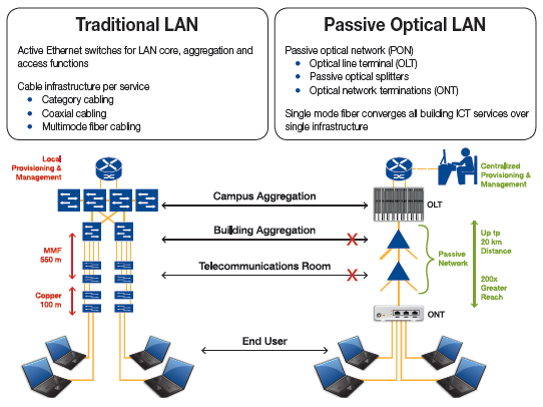Comparing Passive Optical Networks and Passive Optical LANs
With all this talk of smart buildings, convergence and the Internet of Things, it’s important to remember: The only way a building or business can benefit from these trends is by having the right network backbone (LAN) in place.
Today’s networks must be able to ensure uptime, plenty of bandwidth, security and scalability – ideally while keeping energy, cooling, material and labor costs to a minimum.
For this reason, passive optical LANs (POLANs or POLs) are starting to be considered for new deployments.
The Basics of Passive Optical Networks (PONs)
A PON is a point-to-multipoint network using optical splitters and loose tube singlemode fiber for outdoor network deployments.
Passive optical network technology has been around for a long time. Outside plant carrier networks (fiber-to-the-home, or FTTH) providers have been using passive optical network technology for over a decade.
PONs work well because their providers have lots of experience with passive optical networks; they know how much bandwidth a customer (one home, or one dwelling unit) typically consumes, so they can set up their split ratios very efficiently. There is a demonstrated blueprint for where to locate splitters, and what ratios are needed. This has been developed through trial and error over time.
The Basics of Passive Optical LANs
A traditional LAN manages signal distribution with numerous routers and switch aggregators. Passive optical LANs use passive optical splitters, just like PONs, but are adapted to indoor network architectures. As an alternative to traditional LAN, passive optical LAN is also a point-to-multipoint network that sends its signals on a strand of singlemode fiber. POLAN (or POL) utilizes the optical splitters to divide the high bandwidth signal for multiple users, and makes use of wavelength division multiplexing (WDM) technology to allow for bi-directional upstream and downstream communication. A passive optical LAN consists of an optical line terminal (OLT) in the main equipment room and optical network terminals (ONTs) located near end-users.

Because of this setup, passive optical LAN can decrease the amount of cable and equipment required to deploy a network. Compared to traditional copper cabling systems and active optical systems, passive optical LAN streamlines the amount of cabling required within a network. Also, because the splitters are passive (requiring no power and emitting no heat), the power and cooling requirements for traditional intermediate distribution frames (IDFs) or telecommunications rooms (TRs) is drastically reduced or eliminated.
Passive Optical LAN Offers Many Benefits
The waters are a bit uncharted when it comes to passive optical LAN, however – especially compared to outdoor PON. As of right now, there are no established POLAN standards; each vendor works from its own platform (ONTs from one vendor are not compatible with the OLTs of another, for example). Also, there is a much shorter history for POLAN deployments; split ratios are generally not as well understood (how much bandwidth does your engineering department really need?). In the past, passive optical LAN deployments were also completed without following a structured approach, so they often lacked interconnection points for future moves, adds and changes (MACs) and repairs.
As a result, the deployment blueprint for POLAN is not as obvious; however POLAN still offers significant advantages in the right applications. Some of the more favorable fits for POLAN are:
- Hotels
- Campus buildings
- Dormitories
- Hospitals

These applications are a good fit because they are environments in which there exists:
- A proliferation of networks requiring convergence
- A limited amount of space to dedicate to cabling (eliminating some IDFs/TRs that might, for example, provide a hotel with space for another guestroom!)
- A potential need for discrete, secure networks
- A need for easier network support through centralized management
Belden supports the passive side of POLAN by offering a complete ecosystem of splitters, fiber cable and composite (fiber/copper) cable for remote powering, patch cords, rack-mount patch panels and wall-mount patch panels to help you deploy a highly flexible, scalable passive optical LAN.
